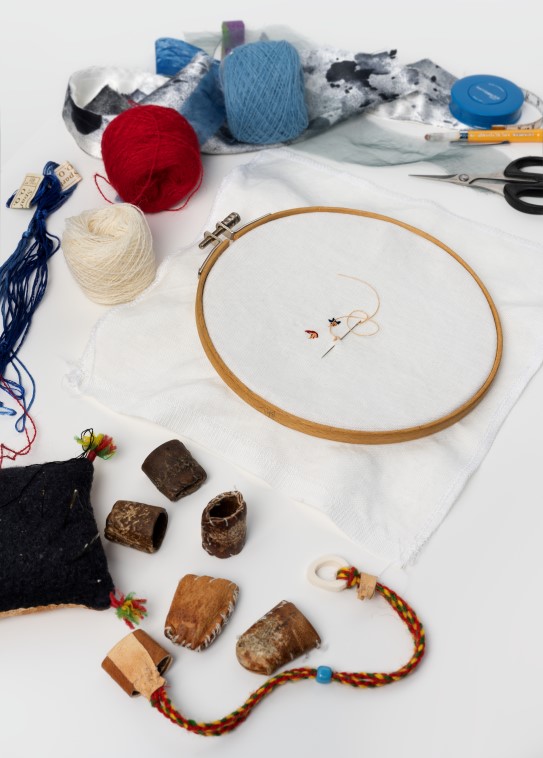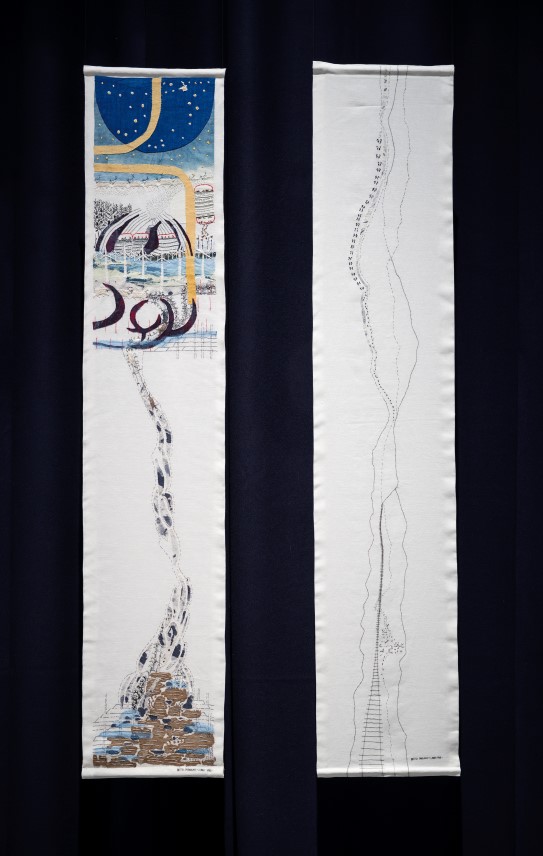
We have scheduled the visit to discuss Marakatt-Labba’s artistic practice, with a particular focus on her process and her preference for embroidery as a medium. At this point in time, she is fully occupied with a work for Beaivváš, the Sámi national theatre in Guovdageaidnu / Kautokeino, for which she has chosen a different format than usual: rather than a broad, horizontal tapestry, this time her elongated narrative will start at the bottom and work its way upwards. A grouse can be seen at the top, imbued with a mythological aura. The bird was believed to herald death to those who came too near, but it is also a stately, poetic representative of a landscape that is primarily the domain of reindeer. The work also features key moments from Guovdageaidnu’s history, including scenes from the Guovdageaidnu Rebellion in 1852, as well as a representation of a lávvu, or Sámi tent, with its areas for seating and sleeping. In many ways, this work summarises her own career as an artist, which has often focused on stories about the Sámi peoples’ everyday life, care for the environment and nature, and dreams and mythologies. It is here, in this bright, spacious workroom, that she has devoted countless hours to creating her art with dogged determination.

Marakatt-Labba decided already at an early stage that she wanted to create textile art. As a child she had been inspired by her mother’s duddjon, or handicraft, and she was sixteen when she started vocational school, with sewing and weaving as her main areas of study. She recalls:
"I knew what I wanted, and what I wanted was a wide-ranging background in several disciplines. The years I spent at the vocational school provided me with unique insights into textiles and how their different qualities are treated, something I benefitted from when I later began studying at HDK, the Academy of Design and Crafts in Gothenburg, in the 1970s. I had a head start there over the other students because they knew nothing about tapestries and textiles. Even though embroidery wasn’t really regarded as a particularly noteworthy art form at the time, it suited me to a tee – I’ve always believed in this medium, even though it requires unending patience and time. It has a lot to do with how you look at the material, how it all fits together. And I think you also have to have your own personality, be a bit stubborn. And that’s me."
Before studying in Gothenburg, she attended a two-year preparatory art programme at Sunderbyn Folk High School in Norrbotten, where she took lessons in drawing, oil painting, printmaking, watercolours, and photography. Her early works testify to her solid drawing skills and assured sense of colour and form.
"It took me a long while to learn to draw. Everyone else would be making these gorgeous sketches at school, but not me – mine were just the worst and ugliest, I think. So, I had to analyse myself: Why did I have such a hard time making sketches? And why didn’t I ever visit the school’s beautiful library? Everyone else was there, getting inspired by the various art books they were browsing through. But I had my own art book in my head. And I didn’t want to destroy this book – I had to work through everything that I wanted to tell so that I could keep hold of everything that I had inside me. And this is an important part of my Sámi heritage. Because when my ancestors sat and sewed, they saw in the very material what it was they wanted to create. And that is something that has followed me."


What typifies Marakatt-Labba’s art is her unique ability to work intuitively and inquisitively: her artistic process is one of trial and error. As a visual artist, she focuses on ensuring that her pictures attain the right balance, and she is aware of how important it is to know when to stop – to know when the composition is just right. She prefers to work without sketches, and she only makes preparatory drawings when doing a commissioned piece. An example of this is Lodderáidaras (The Milky Way), a mixed-media work with appliqué and embroidery that the Norwegian Parliament commissioned in 2022. It hangs in the parliament building’s well-known concourse, an area where politicians and journalists can be found mingling every day for interviews and informal talks. Like a floating universe, the tapestry shines down on us with its glowing sun and sparkling stars.
"For this piece, I thought it would fit to work with circles, because everything is circular," Marakatt-Labba explains. "And Sámi culture is highly influenced by that notion. Reindeer herding, joik singing, the shape of the lávvu – all of this is circular. But it was a very difficult piece to create. You know, textiles have a mind of their own, so I had to pin the textiles down in many places while making the work in order to keep it all in place." Visitors to the building who have the chance to study the piece up close will see that it is undoubtedly a highly detailed masterpiece.
Marakatt-Labba uses small, round frames when she embroiders, even as the pieces themselves can become very large. She uses various textiles to create the background, typically linen or varieties of silk, and she dyes everything herself to achieve the desired effect.
"I use synthetic colours because they last better," she notes. She suddenly opens a drawer and takes out a particularly thin and light piece of organza, which she acquired from a supplier in Wales. "All fabrics contain a good deal of glue to help them retain their colours, so the first thing I do is wash out all of this glue. Then I dye the fabric in a variety of hues – it looks like a watercolour. Later on, I stretch the fabric out on the wall and think about what I want to do with it next."


If we inspect her works even more closely to assess their craftsmanship, we will discover that her earliest works consist of many tight stitches, while her later works are distinguished by their use of appliqué and bolder colours "Yes, it is an evolving process," she explains. "And you do change over the years. Some things can of course be simplified by using appliqué, but I’m still very much interested in how teeny-tiny stitches can be used to bring about a certain effect, for example to create snow."
It is not unusual for viewers to find themselves captivated by Marakatt-Labba’s fantastical, often humorous imagination and naïve charm. She is often inspired by her own dreams, and she always has a notebook lying ready on her nightstand in order to record them. The dreamlike nature of such works comes clearly to the fore in Deattán (Nightmare) from 1984, which depicts a grotesque scenario where a lávvu full of sleeping people is being invaded by large, black rats, representing the authorities. Even though the door goddess Uksáhkká stands guard by the entrance, gnawed-off bones and heads are clearly visible, and there is blood everywhere.
Another major piece that Marakatt-Labba has just started working on is the one that has been specially commissioned for the National Museum’s exhibition. She has been given completely free rein for this piece, and neither the museum nor the artist herself knows yet how it will all turn out. "What I’m envisioning is a forest in this brave new world, full of windmills. What do we find there? It’s all stones and ice flying about. No animals go there because it’s noisy and deadly there in the wintertime. And so maybe some machines will be added to the piece. We’ll see."

Her works evolve into shape with energetic, rhythmic stitches:
If I embroider something incorrectly, I never stop and redo it, I just carry on. There’s no sense in pulling the threads back out, it just takes too much time. Instead, I’ll think of another image to embroider. Sometimes it ends up almost looking like a relief – it’s like you can sculpt a face. So sometimes it’s kind of a good thing to embroider incorrectly, because then you end up with something new. I don’t want it to be too perfectionist – I would rather work more freely, dispersing the stitches here and there until I have covered an entire shape.
Despite her dislike of perfection, she still shows a knack for precision. She manages to pull off the difficult trick of making her images seem effortlessly playful even as she creates what she wants to convey. Every little detail, from the facial expressions to the movements of the trees or branches, require attention and awareness. As we sit there in her studio on this fine spring day in June, when the wintry cold of the north has yet to relent, she tells us that it is during her strolls along the local river, in towards the forest, that images will come to her:
"I see the brown tree trunks standing there with something white in between them, waiting for the greenery to come. Then I think that I want the next embroidery to be just like this. I take pictures in my mind, as though with the click of a camera, so that I can later work from memory. And then whatever happens, happens. The works keep me going – there’s nothing that weighs me down. People around me can sometimes be a bit worried. 'Do you really have to work so much? It’ll be the death of you.' But I enjoy what I do. Embroidering gives you time to think. With watercolours, by contrast, everything happens so quickly. I don’t mind that it takes time."